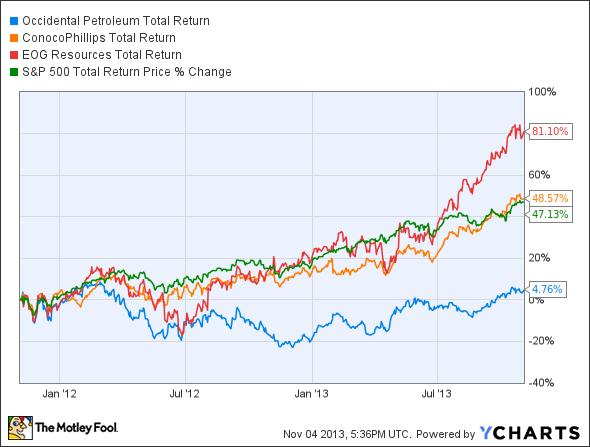There have been lots of oil and gas darlings since the boom in American shale production, but Occidental Petroleum (OXY 0.58%) isn't one of them. Over the past two years, the company has drastically underperformed both the broader market and its peers ConocoPhillips (COP 0.39%) and EOG Resources (EOG 0.67%).
OXY Total Return Price data by YCharts.
Occidental is looking to shake things up and is making moves very similar to ConocoPhillips. If Occidental hopes to replicate the success of its peers EOG and ConocoPhillips, then it will need to avoid these three key risks.
In California, it's complicated

You may not have noticed, but the state of California is the third-largest oil-producing state in the nation and is the fourth-largest region when you include the Gulf of Mexico. Overall, the physical geology of the region is still very promising. The United States Geological Survey estimates that the Los Angeles Basin and the San Joaquin Valley still have about 4.03 billion barrels of oil equivalent still in the ground, and the Monterey Shale formations could boost the proven reserves of the entire United States by 52%!
With production of 148,000 barrels of oil equivalent per day, Occidental is the second-largest producer in California behind Chevron (CVX 0.57%) and has done a commendable job of turning California's older oil formations into profitable ventures. The company is generating a 20% rate of return on its water and steam flood operations, and has plans to implement CO2 flooding in the region to boost recovery from these aging wells.
The issue that could cause Occidental to suffer in California is that production growth could become very hard to come by, especially over the next year or so. Per request of Governor Jerry Brown, the state has embarked on an 18-month environmental review of hydraulic fracturing and how it will affect California. This could delay many future growth for Occidental in a place like the Monterey, where the company has more than 1 million prospective drilling sites. Also, with the entire state starved for water, there could be some very strict limits on water use for hydraulic fracturing in the state.
There are lots of companies that could be hurt by the decisions that will be made by the California state government, but Occidental is in the position to lose the most. While Chevron has more total production in the state, Chevron only relies on California for 6% of its production, whereas Occidental depends on the state for 19.3% of its production.

Source: Occidental Petroleum investor presentation.
Unrest in the Middle East
Using its position as a top enhanced-oil-recovery producer in the United States, Occidental has carved out a large position in the Middle East and North Africa. Today, its presence in this part of the world represents 35% of the total production for the company.
Like the issues that Occidental has had in California, the threat to Occidental from this part of the company's holdings has much less to do with what is going on in the reservoir than what is happening above ground. Anyone who has seen the news in the past couple of years knows Libya has been rife with political turmoil that has shut down oil and gas production there, the U.S. has been been using drone attacks on members of Al-Qaeda in the Arabian Peninsula in Yemen, and Iraq's ambitious plans to triple oil production have been disappointing thus far. Nearly all of these regions have seen a mass exodus from the major oil companies. ExxonMobil has been selling off its contracts in Iraq to anyone that will take them, and other majors are looking to pull out as well.
Luckily for Occidental, Oman, the United Arab Emirates, and Qatar represent more than 75% of the production from this region, and have so far not been as adversely affected by political instability or contract disputes. Still, Occidental is looking to sell working interest in some of its larger projects there and lower its exposure to the region because of the uncertainty that this region presents.
Nailing the dismount
Occidental's management has been under lots of pressure from shareholders to take drastic measures to enhance shareholder value. So to catch up with its peers ConocoPhillips and EOG, it is following their strategic plans. EOG has transformed from a natural gas heavy driller to a major independent oil producer in U.S. in less than three years, and ConocoPhillips is finishing up a major turnaround, where it spun off its midstream assets and is selling almost $10 billion in international assets. Both of these moves have been very productive for ConocoPhillips and EOG so far, and now its Occidental's turn to try it as well.
To make a move like this, though, Occidental's management is going to have to get it right. So far, the company has said it will sell off part of its equity stake in Plains GP Holdings (NYSE: PAGP) as well as part of its Middle East/North Africa assets, with rumors that it may completely spin off its California assets into a stand-alone company as well. Obviously, these areas are a higher risk portion of the portfolio, but they are also significant cash generators that can be used to fuel exploration programs in more promising places like the Permian.
What a Fool believes
Occidental looked in the mirror and didn't like what it saw. So it is looking to turn things around with some asset sales and a stronger focus on its core producing regions like the Permian. Like many companies that are in these sorts of turnarounds, it's difficult to gauge what it will look like on the other end. The issues above will have a very large influence on how it goes through this turnaround, so investors should keep a keen eye on how Occidental deals with these potential hurdles over the next couple of years.





